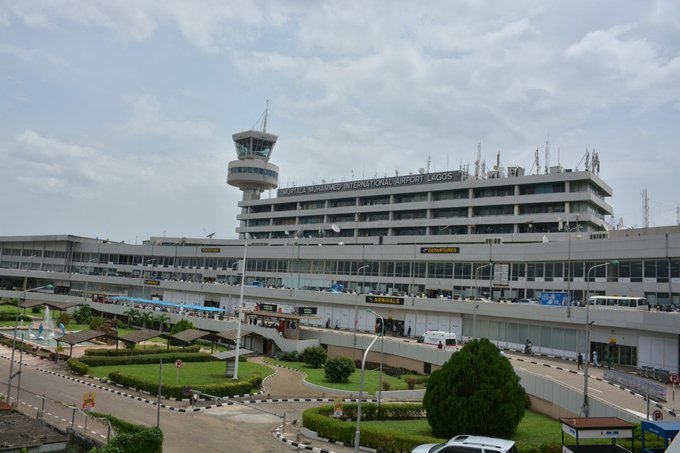Aviation Analysts Decry N712bn Allocation for Airport Refurbishment

The N712 billion refurbishment project for Lagos’ Terminal One’s Murtala Muhammed International Airport (MMIA) is “at quarter to go,” according to Nigerian aviation experts.
Nigeria may have one of the most costly airport projects in the world, it was also disclosed.
The Federal Government should either concession the airport or use public-private partnerships (PPP) instead of spending so much money on airport projects when other infrastructure in the nation is falling behind, according to industry experts.
They also encouraged the administration to be more transparent about the expenditures and to make clear the extent of the effort.
In Abuja, the Federal Executive Council (FEC) approved N712 billion on Thursday for MMIA’s complete renovation, modernization, and improvement.
A comprehensive aviation infrastructure plan worth N900 billion was planned for the nation, with the approval serving as its focal point.
In a press conference, the aviation and aerospace development minister, Mr. Festus Keyamo, stated that the project, which was given to the China Civil Engineering Construction Corporation (CCECC), would demolish the old terminal to its structural core and then rebuild it with new plumbing, electrical, and mechanical systems.
He added that the project would be carried out over a 22-month timeframe. “We have chosen to simplify it to just the carcass and then perform the full mechanical and electrical (M&E) process once more,” he stated.
He emphasized how the administration has moved from making haphazard repairs to overhauling important aviation facilities.
Additionally, the FEC authorized the extension of Terminal Two, which included building a new apron, access roads, bridges, and other associated projects.
Together with the Terminal One project, the entire cost of the airport construction in Lagos came to N712.26 billion, making it the largest single investment in Nigeria’s aviation industry.
According to GlobalData’s construction project database, the N712 billion—roughly $474.6 million at a N1,500 to $1 exchange rate—was astronomically costly in comparison to comparable airport development projects that were undertaken globally in 2024.
The Otay Mesa Metropolitan Airpark in the United States (US), for example, is being built by the City of San Diego (COSD) and Brown Field International Business Park (BFIBP) and is only going to cost $1 billion.
Building aviation infrastructure and auxiliary non-aviation amenities on 134 hectares of land is part of the project. After it is finished, the project is anticipated to generate $500 million in revenue for the area each year and create 4,000 permanent jobs and 8,000 long-term construction jobs.
Additionally, a $1.04 billion new terminal for Romania’s Henri Coanda International Airport is being built.
The Bucharest Airports National Company (CNAB) is constructing a new modular passenger terminal that will minimize reliance on the current terminal and accommodate eight million people annually. The terminal is expected to have a capacity of 20 million passengers annually at Romania’s main airport.
A new passenger terminal spanning 100,000 square meters will be built as part of the project. The terminal will have four halls that can accommodate up to five million passengers annually. Along with installing safety and security systems, it also entails building a 650,000m2 aircraft parking platform, 56 new aircraft parking spaces, 25 boarding gates, 266,000m2 of new taxiways, 9,600 car parking spaces, a 5,000m2 business center, and a 2-story hotel.
For a total of $1.19 billion, the Czech Airports Authority (CAA) intends to enlarge Terminal 2 at Vaclav Havel Airport (PRG) in Prague, Czech Republic.
In order to accommodate 21.2 million people annually, Terminal 2 will be expanded. Additionally, a new parallel runway, a three-lane access bridge, retail establishments, waiting areas, check-in and immigration counters, a cafe and restaurant, and waiting rooms will also be built.
A public space in front of the terminal building, the construction of a new departure and arrival lounge, the enlargement of aircraft stands, and the installation of elevators, security, and safety systems are also included. A 14-gate replacement terminal is being built at Burbank Bob Hope Airport (BBHA), also known as Hollywood Burbank Airport, in California, USA, at a cost of $1.2 billion.
The proposal entails building a new airport terminal on 20 hectares of land. It entails building a two-story, 32,980-square-meter terminal with 14 airplane gates, access roads, and locations for firefighting and aircraft rescue.
In Taiwan, the Civil Aeronautics Administration (CAA) is investing $1.26 billion to create a new terminal building at Kaohsiung International Airport (KHH).
Building a new East Terminal in between the current domestic and international terminals is the first phase of the project. The building of a new West Terminal and the renovation of the current international terminal comprise Phase 2.
At a cost of $1.26 billion, the General Authority of Civil Aviation (GACA) is extending the Hajj and Umrah Terminals at King Abdulaziz International Airport (JED) in Jeddah, Saudi Arabia.
A runway, access roads, load centers, utility networks, parking facilities, related facilities, new arrival halls, and an automated people mover are all part of the project.
The airport’s capacity will increase by 15 million passengers annually thanks to the two terminal buildings. Others include the $1.3 billion extension of Sacramento International Airport in the United States, the $3.3 billion expansion of Brisbane Airport in Australia, the $4.62 billion modernization of Viracopos International Airport in Brazil, and the $4.8 billion Dallas Fort Worth International Airport Terminal in the United States.
In addition, in order to promote economic growth and development in the nation, aviation experts advised the government to use PPPs to construct a more sustainable and effective infrastructure development model.
The project’s budget was excessive and a waste of limited resources, according to Centurion Aviation’s Chief Executive Officer (CEO), Grp. Capt. John Ojikutu.
Since none of the renovations were aeronautical, Ojikutu pointed out that the government could make concessions instead of investing so much money in the project.
He expressed regret that the majority of the unresolved issues found by the International Civil Aviation Organization (ICAO) during its 2004 audits had not been resolved 21 years, and that the nation had also failed to implement periodic maintenance programs for the majority of aeronautical services, such as radar, navigational aids, runways, and taxiways.
Ojikutu went on to say that no non-aeronautical facility could be abandoned if Bi-Courtney Aviation Services Limited (BASL) was able to build the Murtala Muhammed Airport Two (MMA2) in Lagos from the ground up.
He noted that a foreign business had bid $30 billion over 30 years for MMIA concessions at N360 billion a year in 2018. He questioned why the Federal Government, led by former Aviation Minister Sen. Hadi Sirika, had not finished the deal. According to Ojikutu, the government should refrain from funding this kind of infrastructure in the nation because it is “shared by political officeholders.”
According to him, it is a waste of N712 billion, or $460 million, to renovate a terminal. If a $500 million Chinese loan might be used for the MMIA Terminal 2 in Abuja, Kano, and Enugu, then the person suggesting this waste should provide specifics.
“I’ve noticed that Nigerian aviation development over the past 20 years has been characterized by needless spending at quarter-to-go.
Airport perimeter walls in accordance with ICAO Annex 14 and security fences in accordance with Annex 17 should be planned by those in charge of our agencies’ administration once the terminal development is put out to bid.
The government acknowledged that the interior of the terminal building needed to be renovated, according to aviation analyst Capt. Mohammed Badamasi, but he also noted that a significant amount of money had been allocated for this project.
The majority of the funds allocated would be taken out of the taxpayer’s account, he claimed.
Badamasi campaigned for concession of the terminal and other airport terminals nationwide, just like Ojikutu did. In order to continue operating until a concessionaire is ready to replace the government, he continued, “it is necessary to repair the restrooms, air conditioning system, conveyor belts, floor tiles, and refurbish the fingers.”
“The N712 billion is excessive for only comprehensive rehabilitation. If N712 billion seems insufficient, is the equivalent in dollars, $474 million, likewise insufficient?
Read Also: Governments, Industry Leaders from West Africa to Gather in Lagos for Industrial Advancement
It is almost half a billion dollars. Instead, the PPP plan should be implemented, according to Merchant Express Cargo Airlines CEO Capt. Samuel Caulcrick.
According to him, the PPP would renovate the airport’s infrastructure and increase its impact. In order to improve infrastructure management and upkeep, he contended that the government should collaborate with the private sector to benefit from their resources, efficiency, and experience.
The private sector has a stake in producing high-quality outcomes, so Badamasi emphasized that the private funding infusion could be turned into performance bonds to guarantee that the enhanced infrastructure was handled efficiently.
However, he stated that even if the specifics of the N712 billion projects were still being finalized, airport visitors and those planning to travel there should have a smooth journey that incorporates a variety of transportation options, such as air-conditioned buses and light trains. He went on to say: “The government may reallocate the consortium’s deposited resources to other vital sectors of the economy, maximizing the impact of its investments, regardless of what is decided as the private sector’s performance bond injects funds.”
“The performance bonds will reduce infrastructure management risks and give the government a guarantee.”
Additionally, the vice president of the Aviation Safety Round Table Initiative (ASRTI), Alex Nwuba, stated that any terminal enhancement would enhance the passenger experience, but he questioned why. On the other hand, Nwuba urged the government to release its formula.
As a better long-term investment after years of patching, the minister mentioned a comprehensive demolition of the aging terminal. The scope of the work needs to be further clarified by him,” he stated.
Renovation of N712 billion airport: blatant evidence of the government’s wickedness against the populace — LP
Festus Keyamo, the Minister of Aviation and Aerospace Development, recently announced that the Federal Government plans to spend an astounding N712 billion ($475 million) on the renovation of the Murtala Muhammed International Airport in Lagos. The Labour Party (LP) has characterized this as an indication of government malfeasance against the people.
The National Bureau of Statistics estimates that 133 million Nigerians, or 63% of the country’s population, are multidimensionally poor. This makes the “outrageous, insensitive” proposal particularly concerning, according to a statement released by LP on Monday.
The APC-led government is putting luxury ahead of the well-being of the populace, the party stated, adding that “this is not just wicked; it is satanic and speaks to a gross disregard for the plight of the masses.”
It also lamented what it saw as the government’s lack of compassion in supporting the wealthy’s lives with money saved from the elimination of petroleum subsidies rather than raising the standard of living for other Nigerians.
In a statement to the party’s interim national chairman, Senator Nenadi Usman, Senior Special Adviser for Media Ken Asogwa wrote, “To take this lifeline away from the poor and channel the proceeds into a luxury terminal accessible only to the rich is a new low in governmental wickedness.”
The APC administration has given up on any semblance of compassion or responsible leadership. This kind of initiative has obvious commercial potential, so why couldn’t it be carried out using a public-private partnership (PPP) model?
“Even more shocking is the minister’s revelation that the so-called Renewed Hope Infrastructure Development Fund, which will be used to fund this project, is composed of savings from the elimination of fuel subsidies, which were the only significant advantage that the typical Nigerian had from our God-given fossil fuel resources,” he said.
The statement clarified that “terminal buildings are investments that generate revenue worldwide.” Instead of wasting subsidy savings on an exclusive project that only helps a small portion of the population, why not attract private capital with a self-sustaining return on investment? To put it another way, how many Nigerians who were denied the benefits of the subsidy era still fly today? Since fundamental necessities like food, healthcare, and transportation are now considered luxury items, what use do they have for airport terminals? In light of the administration’s well-documented fiscal irresponsibility, Asogwa stated that the LP is not shocked.
He continued by denouncing the Lagos-Calabar coastal highway grant, calling it “a white elephant project estimated at N15 trillion (about $12 billion), costing taxpayers an outrageous N4 billion per kilometer.”
This administration’s hallmark is certainly misaligned priorities. In Africa, Asia, and Europe, we found multiple examples of new, modern airports built from the ground up at significantly lower prices than $475 million.
What justification does this administration have for squandering so much public money on a simple renovation? He remarked, “We genuinely wonder what will shock the conscience of Nigerians if this doesn’t.”





